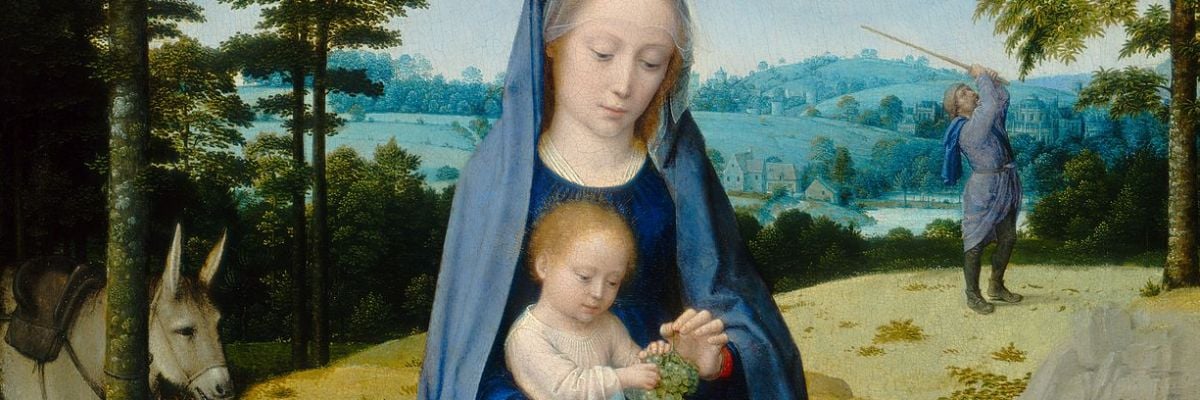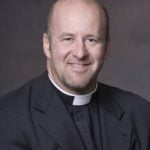
I have long recognized the unique vocation of our Lady, called to the highest honor among all created beings. It is a fact of history that, if true honor is not paid to her as the Mother of God, people put our Lord in her place as the highest of creation rather than adoring him as God Incarnate. —Rev. Msgr. Graham Leonard from The Path to Rome
The former Anglican Bishop of London—now a Catholic priest—sums up the reasoning for the church’s most ancient title for the Blessed Virgin Mary. Put simply, Mary’s title of Mother of God insures Christ’s true place as the unique Son of God and Son of Man.
The title Theotokos means literally “God-bearer.” It is the title used by the Greek fathers from Origen in the early third century, and some even think it can be traced to Hippolytus who died in A.D. 236. (See F. L. Cross, Dictionary of the Christian Church, Oxford University Press [1957]) This term for the Virgin Mary was used increasingly by the early Church, but in the early fifth century it was attacked by Nestorius, who wanted to replace the term Theotokos with Christotokos or “Christ-bearer.”
In a sincere attempt to avoid an earlier heresy called Apollinarianism, which subtly denied the full humanity of Christ, Nestorius used language that was perceived as asserting that there were two separate persons conjoined in Jesus Christ. Thus the Blessed Virgin Mary in giving Jesus human flesh could be the “Christ-bearer” but not “God bearer.” (Patristics scholars today generally acknowledge that Nestorius expressed himself badly and so was misunderstood. He did not actually hold that there were two Persons conjoined in Christ.)
Cyril of Alexandria opposed Nestorius, and the controversy was referred to a Council of Rome in 430. Pope Celestine condemned Nestorius’s teaching, and in the meantime the emperor arranged a general council to meet at Ephesus. In the summer of 431 this council condemned Nestorius and therefore reaffirmed the already ancient title Theotokos. What is clear from the controversy surrounding Nestorius is that the title Theotokos is not primarily an exaltation of the Blessed Virgin Mary but a defense of orthodox Christology. The Council of Ephesus upheld a fully orthodox view of Jesus, and to do this they reaffirmed the devotion to the Blessed Virgin Mary that supported the fullest understanding of Christ’s divinity.
Just twenty years after the Council of Ephesus, another council was held, this time in the city of Chalcedon. In 451 the council dealt with another heresy called Eutychianism. As a result of the council, the Definition of Chalcedon was drawn up. This definition reaffirmed the basic definition of Christ’s divinity given at the Council of Nicea in 325. It also expressly repudiated those who deny the title Theotokos for the Blessed Virgin Mary and reasserted the position that our Lord was “One Person in Two Natures which are united unconfusedly, unchangeably indivisibly inseparably.”
I have gone into a bit of detail about the events of the fifth century for a specific reason. One of the things Catholics and traditional Protestants have in common is that they look to these first councils of the Church for their definition of true belief about the united humanity and divinity of Jesus Christ. The Definition of Chalcedon, based on the earlier definitions of Ephesus and Nicea, is looked to as a test of orthodoxy not only by the Catholic Church and most Eastern churches but also by many Protestant believers. Protestants say they look to Scripture to support their orthodox Christology, but of course their interpretation of Scripture is dependent on the definitions worked out in these early councils and accepted by orthodox Christians since.
The Council of Ephesus specifically upheld the title of Theotokos for the Blessed Virgin Mary, and the Council of Chalcedon expressly repudiated those who would deny Mary that title. Therefore, modern-day Christians who deny Mary the title of Theotokos are actually condemned by the very councils they venerate as having worked out the correct way to articulate orthodox Christology.
One might argue that the councils affirmed the title Theotokos as a minor, incidental matter, but this wasn’t the case. It was affirmed as an integral part of their defense of orthodox Christology. The records of the early Church councils show that devotion to the Blessed Virgin Mary as the Mother of God developed at the same time as the orthodox understanding of Jesus as the God-Man.
Graham Leonard’s pithy statement at the beginning of this article explains why the two beliefs developed together. As the relationship between Jesus’ humanity and divinity came to be understood more fully, it became even more clear that Mary, as his human mother, was specially graced by God in order to make her a fitting mother for God the Son—for example, by being specially preserved from sin. This special relationship to God the Son and the accompanying graces make her the highest of created beings. Devotion to her was therefore intertwined with submission and obedience to her Son, the incarnate God.
The essential unity of man and woman is established in Scripture when Genesis says that both of them were created in the image of God (Gen. 1:27). In marriage men and women re-establish the unity God intended for them, and they live in a state of mutual interdependence as “one flesh.” The Genesis account might show woman being taken from man, but the birth of every man from a woman also establishes the essential unity and interdependence between the genders.
Paul expresses this natural co-dependence between men and women: “For man was not made from woman, but woman from man. . . . Woman is not independent of man nor man of woman, for a woman was made from man, so man is now born of woman” (1 Cor. 11:8, 11–12). In the divine economy man and woman are interdependent, and in the mystery of redemption God chose for both Jesus and his mother to play out the naturally interdependent roles of man and woman.
Some non-Catholics grant Mary the title of Theotokos for theological reasons but do not practice any form of Marian devotion. This is reflective of an illogical and truncated faith, because in every other.aspect of our faith our devotions are inspired by and united to the doctrines we profess. How can one grant Mary the title Mother of God and yet refrain from using the ancient prayer in which we say, “Holy Mary, Mother of God, pray for us now and at the hour of our death”?
Worship of Jesus Christ as “God from God, Light from Light, True God from True God, begotten, not made, of one being with the Father” is therefore a unity with prayerful devotion to his mother. With her and through her we affirm and bow before the one who is God made man.
Those who deny Marian devotion sometimes sincerely object because they believe devotion to Mary detracts from proper worship of her Son. This misunderstands the Church’s teaching and practice. Devotion to the Blessed Virgin is constantly united with the worship of her Son. This unity of belief and practice cannot be separated, and, just as the early Church taught, those who deny that Mary is Theotokos also implicitly impugn the true divinity of her Son by failing to work out its practical implications—even if they are unaware that they are doing so.
Well-known convert Kimberly Hahn has said, “There are three things that keep Evangelicals away from the Catholic Church: Mary, Mary, and Mary.” While it is true that Evangelicals do have a strong resistance to Marian devotion, Catholics should not apologize or back away from the issue. Instead it should be shown that devotion to the Blessed Virgin Mary has been an integral part of orthodox Christianity from the very earliest days of the Church. It should be pointed out that the Church Fathers considered a proper view of Christ to be dependent on a proper understanding of Mary’s identity.
Furthermore, those who object to Catholic practice should be reminded that the vast majority of Christians through the ages and around the world today incorporate the Marian dimension into their Christian lives in daily devotion. Most importantly, it should be stressed that devotion to Mary, rather than being something different than their already keen love for Christ; is instead a fuller experience of his everlasting love.



